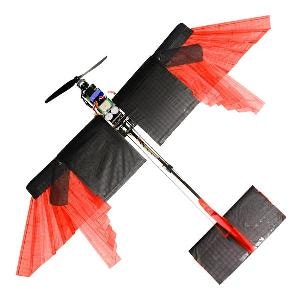Dec 16 2016
 Credit: EPFL
Credit: EPFL
A bio-inspired drone has been built with feathers to enhance its precision during flight. The device can spread or fold its wings while flying, making it more resistant in high winds and easier to maneuver.
Birds alter the configuration of their wings when they want to increase their speed, change direction, or counter headwinds. For example, to steer they spread one wing and retract the other a little. By adjusting their wingspan like this, they create a calculated imbalance that helps them to turn. So far, only birds were able to achieve this so effectively.
When researchers from the Laboratory of Intelligent Systems observed birds in flight, they got the idea of constructing an energy-efficient winged drone capable of altering its wingspan, flying at high speed and moving through tight spaces. Recently, their research has been published in the Royal Society journal Interface Focus.
Dario Floreano and his team were keen to develop a bio-inspired drone that could meet a number of aerodynamic requirements. It had to be capable of making sharp turns, flying between obstacles, and coping with strong winds. By altering its geometry mid-flight, the drone can match all these criteria. The moving component is located on the outer wings. It functions like a bird's quill feathers, which are the large feathers located at the edge of the wing.
We were inspired by birds: they can radically transform the size and shape of their wings because they have an articulated skeleton that is controlled by muscles and covered in feathers that overlap when the wings are folded.
Matteo di Luca
The drone also has been designed with feathers so that it can fold and overlap just like a fan.
One of the many challenges was in designing and constructing the complex morphing mechanism, in other words, imitating nature to build the drone. "It is extremely difficult to find the right balance between aerodynamic efficiency and the weight of the device," explained Stefano Mintchev. The wing is made up of mostly composite materials so as to maximize strength while decreasing total weight.
Morphing wings that can become accustomed to the weather conditions and environment are also a vital issue in aeronautics. Engineers are yet to find a suitable replacement for the rigid wings and ailerons of planes.
With the foldable wings, we discovered that we didn't need ailerons to help the drone turn. By changing the wingspan and surface area during flight, we could make it turn automatically.
Dario Floreano, Head of Laboratory at Intelligent Systems
This winged drone therefore paves the way for new possibilities. Due of its ability to adapt, it could turn out to be very efficient at low altitude, in an urban environment where winds change quickly.
This research was funded by NCCR Robotics.
Source: http://actu.epfl.ch
A drone that flies (almost) like a bird
École polytechnique fédérale de Lausanne (EPFL)/Youtube.com